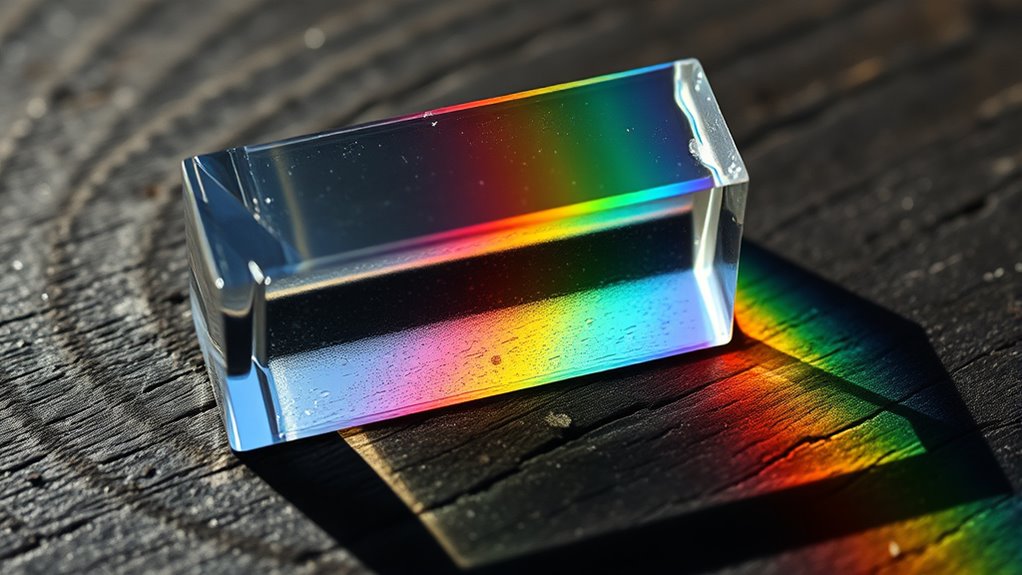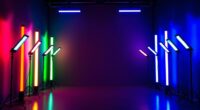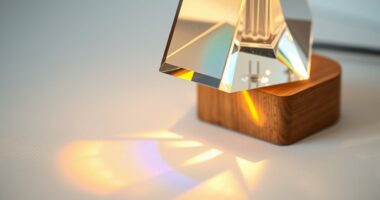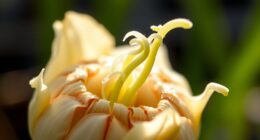To create a pocket rainbow with a water-filled prism, fill a clear container about three-quarters full with water. Hold it in direct sunlight or shine a bright light onto it at an angle. The water causes light to bend differently for each color, producing a beautiful spectrum. Adjust the container’s position or angle to see more vivid colors. If you keep experimenting, you’ll discover even more fascinating effects of light and refraction.
Key Takeaways
- Fill a transparent container about three-quarters full with clean water.
- Hold or angle the container in direct sunlight or under a focused light source.
- Observe the spectrum of colors emerging due to light refraction at the water’s surface.
- Adjust the container’s position, angle, or distance from the light to enhance the rainbow.
- View the rainbow from different angles to see the full spectrum of colors created by dispersion.
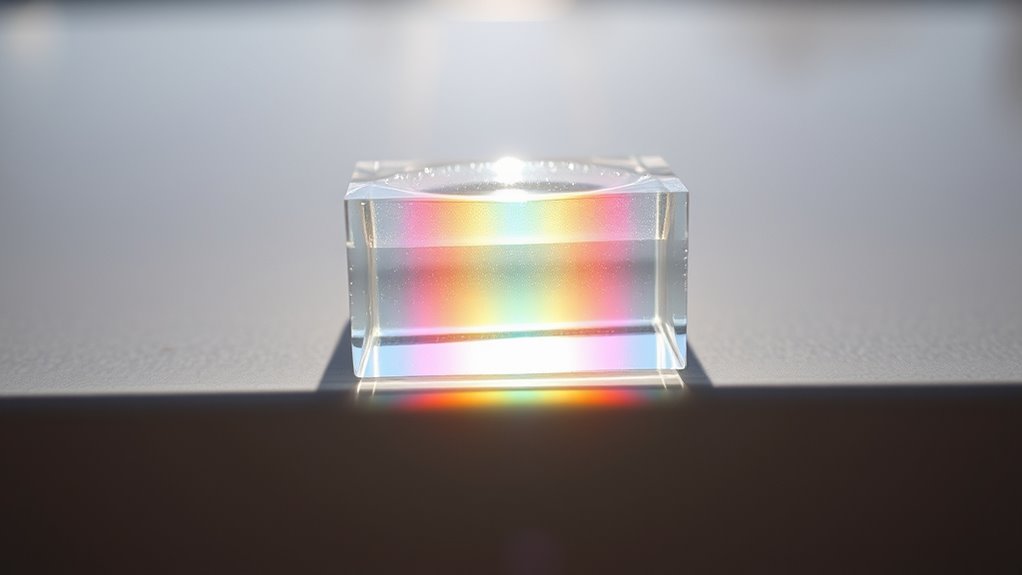
Have you ever wondered how to bring a splash of color and wonder wherever you go? Creating a pocket rainbow with a water-filled prism is a simple and fascinating way to do just that. It all starts with understanding light refraction—the way light bends when it passes through different mediums. When you hold a clear glass or plastic container filled with water at just the right angle, the light traveling through it bends and splits into its component colors, producing a mini rainbow that dances on your hand or nearby surfaces. This phenomenon, known as light refraction, is the key to transforming a plain water-filled container into your personal pocket rainbow.
To craft your water prism, find a transparent container—like a glass or a plastic cup—that’s wide enough to hold water comfortably. Fill it about three-quarters full with clean water. Hold it in direct sunlight or shine a focused light source onto it in a well-lit room. As the light hits the water’s surface, it refracts due to the change in density between air and water. This bending of light causes the prism color to separate, revealing a spectrum of hues that resemble a tiny rainbow. The angle at which you hold the container matters. Tilt it slightly or rotate it in your hand until you see the vibrant display of colors emerge. The spectrum appears because different wavelengths of light bend by different amounts, creating a beautiful dispersion effect.
You can enhance this effect by adjusting the position of the water prism relative to the light source and your eyes. Moving it closer or farther from the light or changing the viewing angle will alter the size and intensity of the rainbow. It’s an incredible demonstration of how light refraction works in everyday life, making complex physics accessible and mesmerizing. The colors you see—red, orange, yellow, green, blue, indigo, and violet—are the result of the prism color phenomenon, where each color bends at a slightly different angle, spreading out across the water’s surface. This simple setup offers endless possibilities for exploration, whether you’re sharing it with friends or just marveling at the natural physics happening right in your hand.
Adjust the water prism’s position to deepen or expand your rainbow’s colors and size.
In essence, making a pocket rainbow with a water prism is about appreciating the magic hidden in simple science. With just a container of water, sunlight or a bright light, and a little curiosity, you can create your own miniature spectrum of colors anytime you want. It’s a delightful reminder that nature’s most beautiful displays often come from the simplest phenomena, waiting for you to discover them. Additionally, exploring how light waves influence the dispersion of colors can deepen your understanding of optical physics in everyday life.
Frequently Asked Questions
Can I Create a Pocket Rainbow With Any Type of Water Prism?
You can create a pocket rainbow with different water prisms, but your results depend on water quality and prism shape. Clear, clean water helps produce vivid colors, while the prism shape influences how light refracts. Some shapes, like triangular or rectangular prisms, work better for rainbow formation. Experiment with different shapes and water conditions to achieve the best, most vibrant pocket rainbow, and guarantee your water stays free of particles for clarity.
How Does the Angle of the Prism Affect the Rainbow?
Imagine a secret dance between light and glass—your prism’s angle guides this performance. When you change the prism angles, you affect how light refraction occurs inside, altering the rainbow’s vividness and spread. A sharper angle bends light more, producing a wider, more colorful spectrum. Conversely, a gentler angle results in a narrower rainbow. So, adjusting the prism angles directly shapes the beauty and size of your pocket rainbow.
Is Special Lighting Required to See the Rainbow Clearly?
You don’t need special lighting conditions to see the rainbow clearly through a water-filled prism. Make sure the prism’s transparency is good, and avoid harsh or direct light that can cause glare. Instead, use natural, diffuse light or soft indoor lighting. Proper lighting conditions help the colors stand out vividly, making your pocket rainbow more striking. Adjust the angle of the prism to optimize the light refraction and enhance your viewing experience.
Can This Experiment Be Done Outdoors or Only Indoors?
Ever wondered if you can do this experiment outdoors? Yes, you can, but outdoor lighting and water clarity matter. Bright, direct sunlight helps create a vivid rainbow, while murky water or shaded areas make it harder to see the colors clearly. For the best results, choose a sunny spot with clean water. Indoors or outdoors, the key is good lighting and water clarity—so pick your spot wisely!
How Long Does the Rainbow Last Once Created?
The rainbow’s durability mainly depends on water evaporation. If you keep the water-filled prism in a humid environment or indoors, the rainbow can last for several hours or even days. However, if it’s outdoors on a hot, sunny day, water evaporation speeds up, causing the rainbow to fade sooner. To prolong its lifespan, keep the prism shaded and avoid direct sunlight.
Conclusion
Now that you’ve crafted your pocket rainbow with a water-filled prism, you’ve revealed a tiny world of color right in your hand. Isn’t it amazing how simple materials can create such stunning displays? Next time you’re curious about light and color, remember this easy trick. With just a few steps, you can impress friends or even enjoy a moment of wonder anytime. So, why not carry your own rainbow and see the magic unfold whenever you like?
